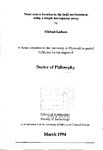Noise source location in the built environment, using a simple microphone array
| dc.contributor.author | Latham, Michael | |
| dc.contributor.other | School of Engineering, Computing and Mathematics | en_US |
| dc.date.accessioned | 2014-01-31T14:32:19Z | |
| dc.date.available | 2014-01-31T14:32:19Z | |
| dc.date.issued | 1994 | |
| dc.identifier | N/A | en_US |
| dc.identifier.uri | http://hdl.handle.net/10026.1/2876 | |
| dc.description.abstract |
An inadequate level of noise attenuation provided by a building element is frequently the result of a lack of completeness in the construction. This often invisible fault acts as a noise source in a room, so in order to undertake remedial work the source position must be found. Recently, near field noise intensity measurement has been the popular method for noise source location in buildings. This method of using intensity studies requires a grid of readings to be taken. An alternative method, the one used in this work, employs a different strategy. Here, the source location is identified by direction scanning of time delays at a number of microphones arranged in a regular three-dimensional array. A novel arrangement of seven microphones, in the shape of a wheel-brace, is used to measure the differences in time taken for the sound waves to travel from a source to the various microphones. The magnitudes of these time differences are combined and converted into the coordinates of the source, relative to an origin which is placed at the centre of the wheel-brace array. The mathematics for this conversion is derived and the errors in the experimental arrangement discussed. The use of this airay for the identification of faults in built structures is explored. A significant contribution is made to the knowledge of noise source location in buildings, since the microphone array is used to demonstrate the location of a noise source irrespective of the direction of the incoming noise. The use of computerised data collection is described for a budget system, where time was cheap, but equipment expensive. The accuracy of the technique would be improved considerably if state-of-the-art electronics were used to measure the lime differences. The feasibility, advantages and potential performance of a modem system, that could be assembled today, is described and discussed. | en_US |
| dc.description.sponsorship | School of Architecture | en_US |
| dc.language.iso | en | en_US |
| dc.publisher | University of Plymouth | en_US |
| dc.title | Noise source location in the built environment, using a simple microphone array | en_US |
| dc.type | Thesis | |
| plymouth.version | Full version | en_US |
| dc.identifier.doi | http://dx.doi.org/10.24382/3879 | |
| dc.identifier.doi | http://dx.doi.org/10.24382/3879 |
Files in this item
This item appears in the following Collection(s)
-
01 Research Theses Main Collection
Research Theses Main


